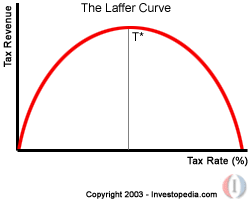The Laffer Curve
Supply-side economics sometimes referred to as Reaganomics, which in turn has been referred to as “Voodoo Economics” is most often explained by the Laffer Curve credited to a young economist named Arthur Laffer. Some stories suggest that while discussing economic theory at a restaurant with some friends Arthur suddenly took a napkin and drew what became known as the Laffer Curve.
Another curve, which could be used to describe the success rates of great ideas first written down on restaurant napkins, might look like this.

Anyway, getting back to the Laffer Curve. The premise is that tax revenue would be zero when the tax rate is 0%, for obvious reasons and also when it is 100%, because there would be no incentive to earn money if it was all going to be taxed. This makes sense.
But Arthur concluded, rather arbitrarily and possible because the restaurant was closing, that these two points had to be connected by a line, which he decided should be a curve. Because a curve has an upslope and a down slope, he concluded that the most tax revenue would be collected when the curve was at its high point and any tax rate higher than this would result in lower revenue.
My problem is this. Why does there have to be a curve connecting those two points and who determines the arbitrary high point. Other than at the 0-mark and 100%-mark, I don’t see the connection between tax rate and tax revenue. The money workers earn and the profits investors make is dictated more by what they get then what they pay out. Take an entrepreneur who makes a million dollars a year but because of a 90% tax rate only gets to keep $100,000. Would he get out of the business and get a job flipping hamburgers because he get to keep all of the $10,000 he makes doing that?
If a person or a company can make so much money, whatever the amount is, why does the tax rate matter, other than at the two extremes? If money were being made, then most people and companies would see that as a good thing, something worthy of continued pursuit. To refuse income because more of it might be taxed seems to be foolhardy and shortsighted.
Now probably the tax-rate area close to 0% and 100% would mimic those two points. But to say 35% or 55% or 75% is going to result in an automatic shutdown of the economy makes no sense. Greedy people might want as much as they can get but I don’t see greedy people saying if I can’t have all or most of it I don’t want any at all. Greedy people do want as much as they can get whatever that amount might be and we sell them short to think they would pull out just because they can’t have it all or even most of it.
We might be able to look back and determine that exact point in time when greedy individuals gave up being greedy because there just wasn’t enough incentive but I don’t think we can predict when it will happen in the future or what event will cause it.
So this is the way my curve would look.

The space in the middle is missing because we just don’t know. It could be a line, a curve, or a series of dots. But I don’t think that area in the middle can tell us anything about what people are or are not willing to pay in taxes.
And if it doesn’t tell us that, then it can’t tell us much about what they’re willing to earn or not willing to earn before they call it a day and drop out of the system.



That space in the middle is the hole Obama is throwing money into. Obamanomics, spending money you do not have.
ReplyDelete